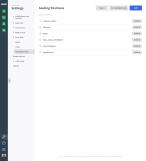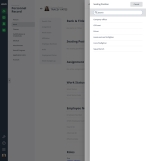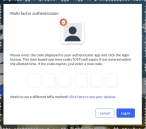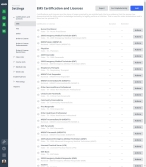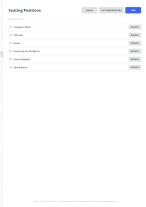Build the seating positions list
Seating positions lay out the expectation of each member in each seat in a response vehicle. Each seat on the truck has a well-defined role at each scene, and it is the responsibility of each rider to perform the task assigned to their seat. Seat assignments also provide crews with accountability.
Example: In a fire apparatus with four fighters, you have the driver's seat, the company officer's seat (the front passenger seat), the irons firefighter seat (directly behind the front passenger seat), and the hook-and-can firefighter seat (the seat directly behind the driver).
Seating positions in the PM module let you record which crew positions the personnel members are eligible to fulfill. Seating Positions can also integrate with either the Scheduling module, or with the roster feature in the Activities and Scheduling modules.
In the Settings screens, you can build a list of seating position menu options that appear when you click the Seating Position field in other areas of the PM module.
|
Example: The seating position menu options you enable on the Settings > Work Lists > Seating Positions screen appear when you click the Seating Position field in other areas of the PM module. |
-
 (If you have not done so already) Access the PM or PM Basic module in the ESO Suite.
(If you have not done so already) Access the PM or PM Basic module in the ESO Suite.
Which version of the module opens depends on whether your agency or department has purchased the PM Basic or full version of the PM module.
-
Do one of the following.
-
(If you are already working in the ESO Suite) Click the Home icon in the upper left corner of the screen.
-
 (If you have not yet logged in) Log in to the ESO Suite.
(If you have not yet logged in) Log in to the ESO Suite.
-
In a web browser, go to https://www.esosuite.net/EsoSuite.
The ESO Suite login screen appears.
-
Enter your user name, password, and agency name, then click Let's Go.
If MFA is enabled, the Multi-factor authentication dialog box appears, displaying one or more methods you can use to verify your login credentials. The number of methods that appear in the dialog box depends on what MFA methods your ESO Suite administrators enabled in the Admin module.

Click graphics
to open them.Information on enabling MFA and specific MFA methods is available in the Admin module online help, in Configure multiple-factor authentication.
Note: If your ESO Suite administrators have disabled MFA ("opted-out"), this dialog does not appear.
-
(If the Multi-factor authentication dialog box appears) Depending on which buttons appear in the dialog box, verify your login in one of the following ways.
 With an authenticator application.
With an authenticator application.
-
Click MFA verification via authenticator app.
The dialog box updates with boxes for entering the numbers of the authentication code, and the ESO Suite sends an authentication code to the authenticator application installed on your device.
-
Open your authenticator application and note the authentication code currently displayed.
-
Enter the authentication code displayed in the authenticator application.
-
Click Log In.
 With a text message (SMS).
With a text message (SMS).
-
Click MFA verification via SMS.
The dialog box updates with boxes for entering the numbers of the authentication code, and the ESO Suite sends an authentication code to the phone number recorded in your PM records and identified with MFA codes.
-
Enter the authentication code sent to your MFA-registered phone number.
-
Click Log In.
 With an email message.
With an email message.
-
Click MFA verification via email.
The dialog box updates with boxes for entering the numbers of the authentication code, and the ESO Suite sends an authentication code to your agency or department email address, recorded in your PM records.
-
Enter the authentication code sent to your agency or department email address.
-
Click Log In.
-
-
The ESO Suite landing screen appears.

Click graphics
to open them.Note: If MFA is enabled, you can access and manage your MFA options through the PM module, on the Settings > Account page, as described in Manage a user account. If your agency or department has enabled MFA but has not purchased the full-featured version of the PM module, you can access your own MFA settings by clicking Change my Multi-Factor Authentication settings on the landing screen, then using the Settings > Account page that appears. If your agency has not enabled MFA, the Change my Multi-Factor Authentication settings link does not appear on the landing screen.
-
-
On the top side of the home screen, click PM.
Tip: If your screen or browser window is too narrow to display all your agency's ESO Suite module icons, an options icon appears on the right side of the icon bar. If you click the options icon, a menu appears containing additional module icons.
A list of all the personnel in the PM module appears, displayed in a grid format.
PM (full version) PM Basic Note: If you can access the full-featured PM module, you can view all your own information in it. The amount of information you can edit in the PM module depends on what roles and permissions your ESO Suite administrator assigned to your user account.
Information on user accounts, roles, and permissions is available in Manage a user account.
-
-
In the left pane, near the bottom, click the Settings icon.

If you have the necessary permissions assigned to your ESO Suite user roles to configure settings, the Settings screen appears. The list of features that appears in the left pane reflects your permissions to access and configure the PM module
Click graphics
to open them. -
In the left pane, expand Work Lists, then click Seating Positions.
A list of seating positions appears in the left pane.
-
Work with the list of seating positions in any of the following ways.
 Disable or enable a seating position.
Disable or enable a seating position.
You can disable a seating position, so that the corresponding menu option does not appear in other areas of the PM module. You can always re-enable a seating position later, if needed.
-
On the right side of the listing, click Actions, and choose Disable.
A red Disabled label appears to the left of the seating position, and the seating position moves to the bottom of the list.
-
On the right side of the listing, click Actions, and choose Enable.
This option appears only if you disabled the seating position in the past.
The red Disabled label disappears to the left of the seating position, indicating that the seating position will appear again as a menu option in other areas of the PM module.
 Sort the seating positions list alphabetically.
Sort the seating positions list alphabetically.
You can sort the list alphabetically to help find an item quickly.
-
In the upper right corner of the screen, click Sort Alphabetically.
The list sorts from A-Z.
 Change the seating positions list order.
Change the seating positions list order.
Because some seating positions are used more frequently, you can sort the order of seating positions in the list for convenience when creating or updating personnel records.
Example: Every vehicle in your agency or department's fleet has requires a driver. It is convenient to have the Driver seating position appear at or near the top of the list, for easy selection when adding or updating personnel records.
-
Place your mouse pointer on the item you want to move to a new position in the list, drag it up or down the list to the position you want it to have in the list order, then "drop" the item where you want it to be in the list.
As the item you are dragging moves over each item in the list, the list items move up or down in the list to make room for the item in its new position in the list order.
 Video: Order the seating positions list
Video: Order the seating positions list
Note: While the video below demonstrates changing the order of items in the immunizations list, the same drag-and-drop process applies to all module lists where you change the list order.
Note: The list order in the Settings > Work Lists > Seating Positions screen determines the list order that appears in drop-down menus in the rest of the module. Disabled values on the Settings > Work Lists > Seating Positions screen do not appear for fields in the rest of the module.
-
-
 (Optional) Export the seating positions list.
(Optional) Export the seating positions list.
You can export a list of all the seating positions currently listed in the module, regardless of whether they are enabled or disabled. The list exports to a comma-separated values (*csv) file, which may be read with Microsoft Excel or other software applications, and includes each seating position and is status (active or deactivated).
